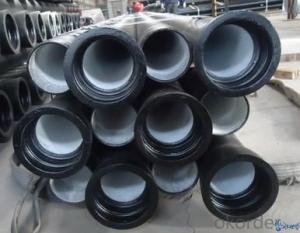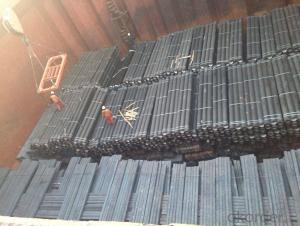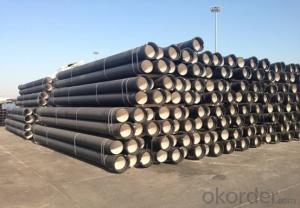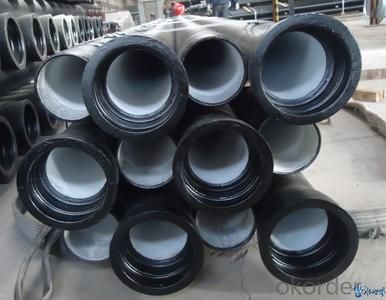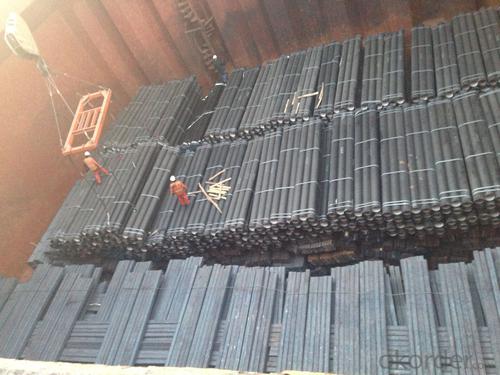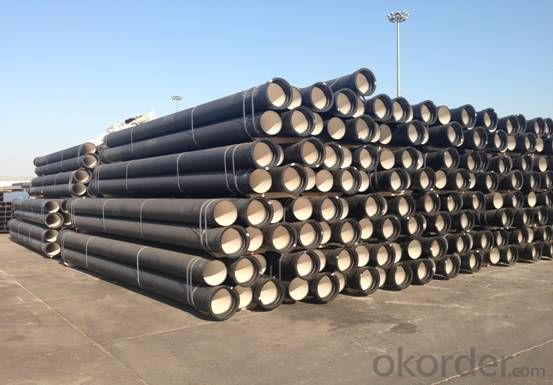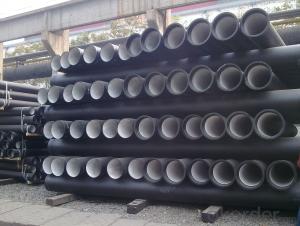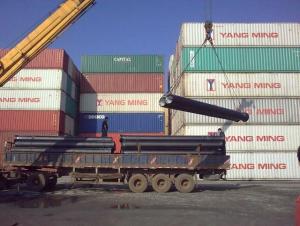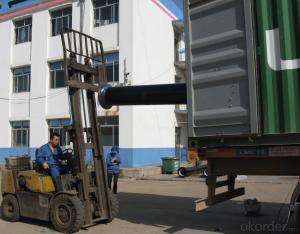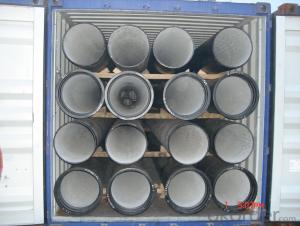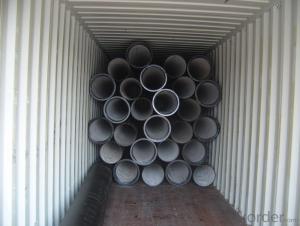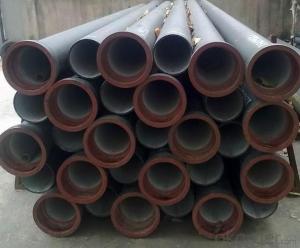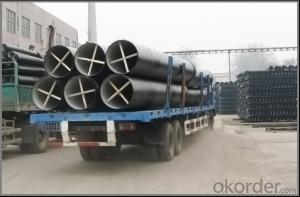DUCTILE IRON PIPES K8 DN150
- Loading Port:
- China Main Port
- Payment Terms:
- TT OR LC
- Min Order Qty:
- -
- Supply Capability:
- -
OKorder Service Pledge
OKorder Financial Service
You Might Also Like
Ductile Iron Cast Pipe is without any defects compare with tradition casting tech, which has many advantages particularly as follow:
(1) High density. In the "vertical upward casting" process, the melt iron of centre liquid column in center crystallizer is continuously feeding for volume shrinkage caused by condensation tube at outer circumference , which lead to be free of shrinkage porosity.
(2) High purity. When melt iron pouring, the mixed impurities such as gas, dross, sand grain which are lighter than melt iron could be eliminated at furnace mouth, its impossible to enter into the crystallizer through the channel, so the melt iron into the crystallizer is very pure.
(3) Strength with toughness. The cooling speed provided by continuous crystallizer is 30 times than sand casting and 5 times than centrifugal casting, and doesn't produce white iron, the eutectic cell volume of continuous cast iron is one eighth to one tenth compare with traditional cast iron. The density of graphite nodule in ductile iron can reach 300-700 pcs/mm2. Therefore, all reason above improve the strength and toughness of continuous cast iron.
(4) Free machining. The high speed cooling make the hardening phase (such as boride, steadite) not appear like reticular, massive or thick, but diffuse like fish bone and pane in shape, moreover, there are tiny graphite flakes inlaid hardening phase. It's free machining in BrinellHardness the range of 250-300HB. However, the Brinell Hardness of 250 is top limit to common metal materials.
(5) Uniform composition of tube wall. The convection mixing of liquid column caused by marching type drawing in crystallizer make the composition of tube wall well-distributed, and concentration gradient very little.
(6) High productivity. To the wall thickness of tube under 10mm, the speed of continuous casting is 1 meter/min, to the wall thickness of tube under 20mm, the speed of continuous casting is 0.5 meter/min, which is high efficiency that centrifugal or other casting tech couldn't reach.
- Q: What are the specifications of cast iron pipes?
- To be divided into: cast cast pipe. Cast iron pipes are used for water supply, drainage and gas transmission lines. They include cast iron pipes and pipe fittings. Labor intensity is small. According to the casting method, it is divided into continuous cast iron pipe and centrifugal cast iron pipe, in which the centrifugal cast iron pipe is divided into sand mould and metal type two kinds. Divided into gray cast iron pipe and nodular cast iron pipe according to different material. Rubber ring seals for flexible interfaces,
- Q: Can ductile iron pipes be used for pressure reducing stations?
- Yes, ductile iron pipes can be used for pressure reducing stations. Ductile iron pipes are known for their high strength and durability, making them suitable for handling high-pressure applications. They have excellent resistance to corrosion and can withstand the mechanical stresses and strains associated with pressure reducing stations. Additionally, ductile iron pipes have a smooth interior surface, which reduces friction losses and helps maintain a constant and controlled pressure within the system. Therefore, ductile iron pipes are a reliable and commonly used material for pressure reducing stations.
- Q: How do ductile iron pipes perform in extreme weather conditions?
- Ductile iron pipes have excellent performance in extreme weather conditions. Their high tensile strength and flexibility allow them to withstand freezing temperatures, heavy snow loads, and extreme heat without cracking or breaking. Additionally, their corrosion-resistant properties make them highly durable and reliable in harsh weather environments, ensuring long-term performance and minimal maintenance requirements.
- Q: What is the wall thickness of K10 grade dn=400 ductile iron pipe?
- Ductile iron pipe is a kind of cast iron. It is an alloy of iron, carbon and silicon. Graphite is exist in spherical form, usually graphite size is 6-7, casting spheroidization grade control requirements for 1-3 quality (spheroidization rate greater than 80%), so the mechanical properties of the material itself has been improved, has the essence of iron, steel performance. The annealed ductile iron pipe is composed of ferrite and pearlite. The mechanical properties of the ductile iron pipe are better.
- Q: Water supply pipe is ductile iron, then it's fittings and valves and other parts must be ductile iron?
- Not always。Valve material selection is mainly determined by the fluid medium.The medium can be divided into gas, liquid, corrosive gas, liquid and oil. According to different media, temperature, and pressure levels, choose different materials, plastic, cast iron, cast steel, stainless steel and so on.
- Q: What is the typical weight of ductile iron pipe?
- The typical weight of ductile iron pipe can vary depending on its diameter and wall thickness. However, as a general guideline, a 6-inch diameter ductile iron pipe with a wall thickness of 0.25 inches may weigh around 35 pounds per linear foot. Similarly, a 12-inch diameter ductile iron pipe with a wall thickness of 0.375 inches could weigh approximately 115 pounds per linear foot. It is important to note that these weight estimates are approximate and may vary slightly depending on the specific manufacturer and product specifications.
- Q: How are ductile iron pipes tested for hydrostatic pressure?
- For water and wastewater applications, ductile iron pipes are widely used because of their strength and durability. To guarantee their quality and dependability, these pipes undergo hydrostatic pressure testing. The process of hydrostatic pressure testing involves applying internal pressure on the ductile iron pipes at levels higher than their normal operating pressure. This is done to evaluate their ability to withstand the maximum pressure they may encounter during their service life. To begin the testing, a sample set of pipes is carefully selected from a production batch or shipment. These samples are meticulously prepared by removing any surface coatings or debris that could affect the accuracy of the test results. The prepared samples are then placed in a specially designed test rig or test line. The test rig is equipped with all the necessary connections, valves, and gauges to accurately control and monitor the test conditions. Once the samples are secured in the test rig, water or another suitable test fluid is slowly introduced into the pipes. The pressure is gradually increased to a preset level, typically surpassing the expected operating pressure by a certain factor. This elevated pressure is maintained for a specified duration, usually several hours, to evaluate the structural integrity and leak resistance of the pipes. Throughout the test, the pipes are closely monitored for any signs of leakage, deformation, or failure. Skilled technicians or engineers observe the pressure gauges and visually inspect the pipes for any visible defects or abnormalities. Additionally, automated systems may be used to continuously record and analyze the pressure readings, ensuring accurate data collection. After the specified test duration, the pressure is gradually released, and the pipes are meticulously inspected for any permanent deformation or residual stress. This inspection may involve visual examination, dimensional measurements, or non-destructive testing techniques like ultrasonic testing or magnetic particle inspection. The test results are then assessed against the relevant industry standards or specifications to determine if the pipes comply with safety and performance requirements. If the pipes pass the hydrostatic pressure test, they are considered suitable for their intended application. However, if any issues or failures are identified, further investigation, analysis, or corrective actions may be necessary before the pipes can be approved for use. In conclusion, hydrostatic pressure testing plays a vital role in ensuring the quality and reliability of ductile iron pipes. By subjecting these pipes to rigorous testing procedures, manufacturers can provide customers with pipes that meet the highest standards of safety and performance.
- Q: What are the different corrosion protection options for ductile iron pipe?
- There are several corrosion protection options available for ductile iron pipe to ensure its longevity and durability. These options include: 1. Cement Mortar Lining: This involves coating the inner surface of the pipe with a layer of cement mortar, which acts as a barrier between the pipe and corrosive elements in the water or soil. Cement mortar lining provides excellent corrosion resistance and can last for several decades. 2. Polyethylene Encasement: This method involves wrapping the ductile iron pipe with a layer of polyethylene material. The polyethylene acts as a physical barrier, protecting the pipe from external corrosive elements. Polyethylene encasement is commonly used in aggressive soil conditions and can offer long-lasting protection. 3. Internal and External Coatings: Various types of coatings can be applied to the inner and outer surfaces of the ductile iron pipe to provide corrosion resistance. These coatings can be epoxy, polyurethane, or fusion-bonded epoxy (FBE) coatings. These coatings create a barrier between the pipe and the surrounding environment, preventing corrosion. 4. Cathodic Protection: This method involves using an electrical current to protect the pipe from corrosion. Cathodic protection systems can be either galvanic (sacrificial anode) or impressed current systems. These systems direct the flow of electrons to prevent the oxidation of the ductile iron pipe. 5. Zinc Coating: Zinc coating, also known as galvanizing, involves applying a layer of zinc to the surface of the ductile iron pipe. The zinc acts as a sacrificial anode, corroding instead of the iron pipe. Zinc coating provides effective corrosion protection, particularly in soil conditions with low resistivity. It's important to note that the choice of corrosion protection option for ductile iron pipes depends on various factors such as the environment, water chemistry, soil conditions, and expected service life. Consulting with corrosion protection specialists and engineers can help in selecting the most suitable option for specific applications.
- Q: Can ductile iron pipe be used for hydropower systems?
- Yes, ductile iron pipe can be used for hydropower systems. Ductile iron pipes are known for their strength, durability, and high-pressure capabilities, making them suitable for transporting water in hydropower systems. Additionally, ductile iron pipes have excellent corrosion resistance, which is crucial for long-term use in water-based applications.
- Q: What is the difference between cast iron pipe and seamless steel pipe and galvanized steel pipe?
- Seamless steel pipe: a pipe with a hollow cross section, used as a conduit for transporting fluids, such as pipelines for transporting petroleum, natural gas, gas, water, and certain solid materials. Compared withsteel and roundsteelinsolid, flexural torsional strength in the same time, the weight is light, is a kind of economic section steel, widely used in the manufacture of structural parts and mechanical parts, such as the oil pipe, automobile transmission shaft, the bicycle frame and steel construction with scaffold with steel pipe manufacturing ring parts can be improved the utilization rate of materials, simplify the manufacturing process, material saving and working hours, has been widely used to manufacture steel tube.
Send your message to us
DUCTILE IRON PIPES K8 DN150
- Loading Port:
- China Main Port
- Payment Terms:
- TT OR LC
- Min Order Qty:
- -
- Supply Capability:
- -
OKorder Service Pledge
OKorder Financial Service
Similar products
Hot products
Hot Searches
Related keywords
